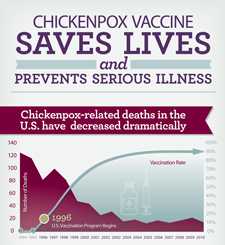Chickenpox Vaccine Saves Lives and Prevents Serious Illness
A Success Story of the U.S. Chickenpox Vaccination Program
What is Chickenpox?
Chickenpox is a very contagious disease caused by the varicella-zoster virus. It causes a blister-like rash, itching, tiredness, and fever.
It spreads when you come into direct contact with virus particles from chickenpox blisters or you breathe in virus particles from chickenpox blisters. It can also spread in the air through respiratory droplets.
Chickenpox can be especially serious in babies, adults, and people with weakened immune systems.
Chickenpox can infect people who have never had chickenpox or never received the chickenpox vaccine.
The United States has made significant progress toward protecting people against chickenpox. A walk back in time shows the many successes along the way.
For years, parents across the United States told stories about how they held and cared for their children as they suffered from chickenpox. While most of these children recovered, some became so ill that they needed to be hospitalized and some died.
Amy, the mother of 13-month old Zoe, learned just how serious chickenpox can be. Soon after her first birthday Zoe became very ill with chickenpox and spent a week in isolation at the hospital. Thankfully, Zoe recovered.
A New Vaccine is Developed
Dr. Michiaki Takahashi developed the chickenpox vaccine in the mid-1970s at Osaka University. He once described how his mission to develop a vaccine began after watching his own son suffer from chickenpox. Thanks to Dr. Takahashi’s work, millions of people in the United States and worldwide receive chickenpox vaccine each year and are protected against severe disease from chickenpox.
CDC’s Mission to Fight Chickenpox
The United States started the chickenpox vaccination program for children in 1996. We were the first country to recommend routine vaccination to reduce the burden of chickenpox. Before the vaccination program, about 4 million people in the United States got chickenpox, over 10,000 were hospitalized, and 100 to 150 died each year.
Initially, CDC routinely recommended one dose of chickenpox vaccine for children 12 to 18 months. Routine vaccination with one dose significantly reduced the number of people who got chickenpox. Although outbreaks were significantly reduced in both size and number of cases, health departments continued to see some outbreaks, including among highly vaccinated student populations. So in 2007, CDC changed the recommendation so that children receive two doses of chickenpox vaccine, the first at age 12 to 15 months and the second at 4 to 6 years.
Thousands of Cases Prevented
Today, more than 90% of U.S. children are vaccinated with one dose of chickenpox vaccine. Each year, chickenpox vaccine prevents an estimated 3.5 million cases in the United States, and is almost 100% effective at preventing severe cases.
Although it is still possible for vaccinated people to get chickenpox, the symptoms are usually milder with fewer blisters and mild or no fever. Chickenpox cases have declined about 92% in the United States from the period before the vaccination program started and chickenpox outbreaks rarely occur.
Hundreds of Lives Saved
Every year, routine chickenpox vaccination prevents 100 deaths among people of all ages and has nearly eliminated chickenpox-related deaths among children. Vaccination also prevents 9,000 hospitalizations every year.
Healthcare Costs Avoided
A typical case of chickenpox can cost a family over $350 from out-of-pocket and other costs associated with the caregivers’ time away from work. However, for most families the cost of a dose of chickenpox vaccine or the copay amount is $0. Thanks to the Vaccines for Children Program (VFC), an estimated 40 million children received vaccines in 2010 whose parents might not have otherwise been able to afford them. For the country, each $1 spent on the U.S. chickenpox vaccination program saves almost $3 in direct and societal costs.
The Way Forward
Chickenpox vaccination saves lives and prevents serious illness. CDC continues to work with local and state health departments to monitor chickenpox and the impact of the U.S. chickenpox vaccination program. The Healthy People 2020 goals include reducing chickenpox cases in children, increasing two-dose coverage for adolescents, and maintaining high rates of one- and two-dose vaccination among children.
Parents, physicians, CDC, other federal agencies, VFC, health departments, and partners continue to make the U.S. chickenpox vaccination program a huge success.
For more information, visit
References:
- CDC. National Immunization Surveys for 19-35 month-olds, 1996-2010. Available at https://www.cdc.gov/vaccines/imz-managers/coverage/nis/child/index.html
- CDC. National Centers for Health Statistics. Underlying cause of death database, 2008-2010. Available at: http://wonder.cdc.gov/
- CDC. Unpublished data from the National Notifiable Disease Surveillance System (NNDSS). 2009-2012.
- Lopez AS, Zhang J, Brown C, Bialek S. Varicella-related hospitalizations in the United States, 2000-2006: the 1-dose varicella vaccination era. Pediatrics. 2011;127:238-45.
- Marin, M., Zhang, J. X., & Seward, J. F. (2011). Near Elimination of Varicella Deaths in the US After Implementation of the Vaccination Program. Pediatrics, 128(2), 214-220.
- Roush, S. W., Murphy, T. V., & Vaccine-Preventable Disease Table Working Group, a. (2007). Historical comparisons of morbidity and mortality for vaccine-preventable diseases in the united states. Jama, 298(18), 2155-2163.
- Zhou, F., Ortega-Sanchez, I. R., Guris, D., Shefer, A., Lieu, T., & Seward, J. F. (2008). An Economic Analysis of the Universal Varicella Vaccination Program in the United States. Journal of Infectious Diseases, 197(Supplement 2), S156-S164
- 2013 dollars calculated using Medical Care Service Component of the Consumer Price Index which is available from the United States Department of Labor. Bureau of Labor Statistics. http://data.bls.gov/cgi-bin/surveymost?cu
- Page last reviewed: November 4, 2014
- Page last updated: November 4, 2014
- Content source:


 ShareCompartir
ShareCompartir
